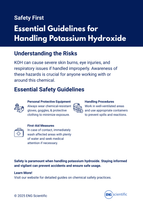Apr 8th 2025
Understanding Potassium Hydroxide: Uses and Safety Guidelines
A powerful inorganic chemical, potassium hydroxide (KOH) is used very widely in many different businesses, laboratories, and even household products. KOH is very commonly used in the production of chemicals, cleaning, farming, and medicine due to its strong alkalinity. Potassium hydroxide has a number of benefits, but due to its highly corrosive nature, it needs to be handled carefully. Everyone who handles or comes into contact with this material should know its uses and safety measures.
What is Potassium Hydroxide?
White and solid, potassium hydroxide easily dissolves in water. It is an essential ingredient in soaps, detergents, and cleaning products because it dissolves in water to produce a very alkaline solution that can effectively break down organic materials. KOH is a strong base that produces potassium salts when it reacts with acids. It is often produced by electrolyzing potassium chloride, which splits the hydroxide and potassium ions. The result is a versatile chemical that is used in everything from personal care products to industrial applications.
Common Uses of Potassium Hydroxide
Production of liquid soaps and detergents is among the most common uses of potassium hydroxide. KOH is responsible for the production of soft, liquid soaps that are highly effective in oil and dirt dissolving, unlike sodium hydroxide, which is utilized in producing solid soap bars. KOH is a key component of degreases, drain cleaners, and disinfectants due to its ability to dissolve fats, oils, and proteins. Consequently, it is applied in numerous domestic and industrial cleaners.
Potassium hydroxide is an essential fertilizer component within the agricultural sector. Potassium, a vital nutrient which stimulates plant growth, strengthens roots, and enhances disease resistance, is supplied by it. KOH is also employed by farmers to manage the pH of the soil, ensuring crops receive the right proportion of nutrients to grow healthily.
In addition, potassium hydroxide is beneficial to the pharmaceutical and cosmetics industries. It is used in the production of drugs, hair removal creams, and skin care products. KOH aids in the process of saponification in creams and lotions and aids in cosmetic formula pH balance in small, controlled amounts.
The food industry is one such significant sector where potassium hydroxide is utilized. It is used as a food additive in order to stabilize ingredients, regulate acidity, and improve texture. Certain food processing companies utilize it to skin fruits and vegetables, produce chocolate, and produce soft drinks. In order to ensure consumer safety, its use in foods is strictly limited due to its high alkaline nature.
Safe Handling of Potassium Hydroxide Guidelines
Potassium hydroxide is a highly corrosive substance that must be handled carefully despite the numerous uses it has. If inhaled in powdered form, KOH can lead to respiratory issues, eye injury, and severe skin burns. Proper safety measures must be employed when handling potassium hydroxide to prevent accidents and health risks.
When handling KOH, personal protective equipment (PPE) is essential. In order to prevent skin and eye exposure, protective attire, chemical-resistant gloves, and safety glasses must be worn at all times. To reduce the risk of burns, KOH needs to be immediately washed from the skin using a lot of water. Medical attention and washing with water for a minimum of 15 minutes are imperative in the event of eye exposure.
It's important to treat potassium hydroxide solutions in areas of good ventilation. Shortness of breath, coughing, and respiratory distress may be caused by inhaling KOH dust or fumes. Sufferers are recommended to move to fresh air and seek medical attention if exposure occurs.
Storage of potassium hydroxide also requires safety precautions. It must be kept away from moisture and incompatible substances such as acids in a dry, tightly closed container. Spills of KOH accidentally can lead to heat and splashing hazards, which can produce burns or cause property damage as KOH reacts vigorously with water. In order to ensure workplace safety, proper labeling and handling procedures should be followed.
Environmental Impact and Disposal
Potassium hydroxide, as with most chemicals, should be disposed of to prevent causing harm to the environment. Abuse of KOH solutions can lead to water pollution and soil contamination; neutralization with a weak acid, such as vinegar or citric acid, can be used to reduce the effect. Most industries follow strict disposal regulations provided by governing authorities to ensure that KOH waste does not harm ecosystems.
Potassium hydroxide spills must also be treated with care. In case of a leak, the chemical can be absorbed using materials like sand or inert absorbents prior to proper disposal. Due to its potential to harm aquatic organisms and change the water's chemistry, KOH must not be directly poured into drainage systems or natural bodies of water.
Conclusion
A resilient and versatile material, potassium hydroxide is crucial to various industries such as soap making, farming, and medicine. Even though it has a number of benefits, caution and careful handling are required because of its extremely caustic nature. Individuals who handle KOH can ensure efficiency and safety in their own industries by knowing its dangers and uses. The secret to safely working with potassium hydroxide is possessing the proper information and taking the proper precautions, whether it is being used in laboratories, industrial processes, or everyday household products.
Handle potassium hydroxide with confidence—its power is unmatched, but safety is key. Visit ENG Scientific to explore high-quality chemical solutions and expert guidance for your laboratory needs.

